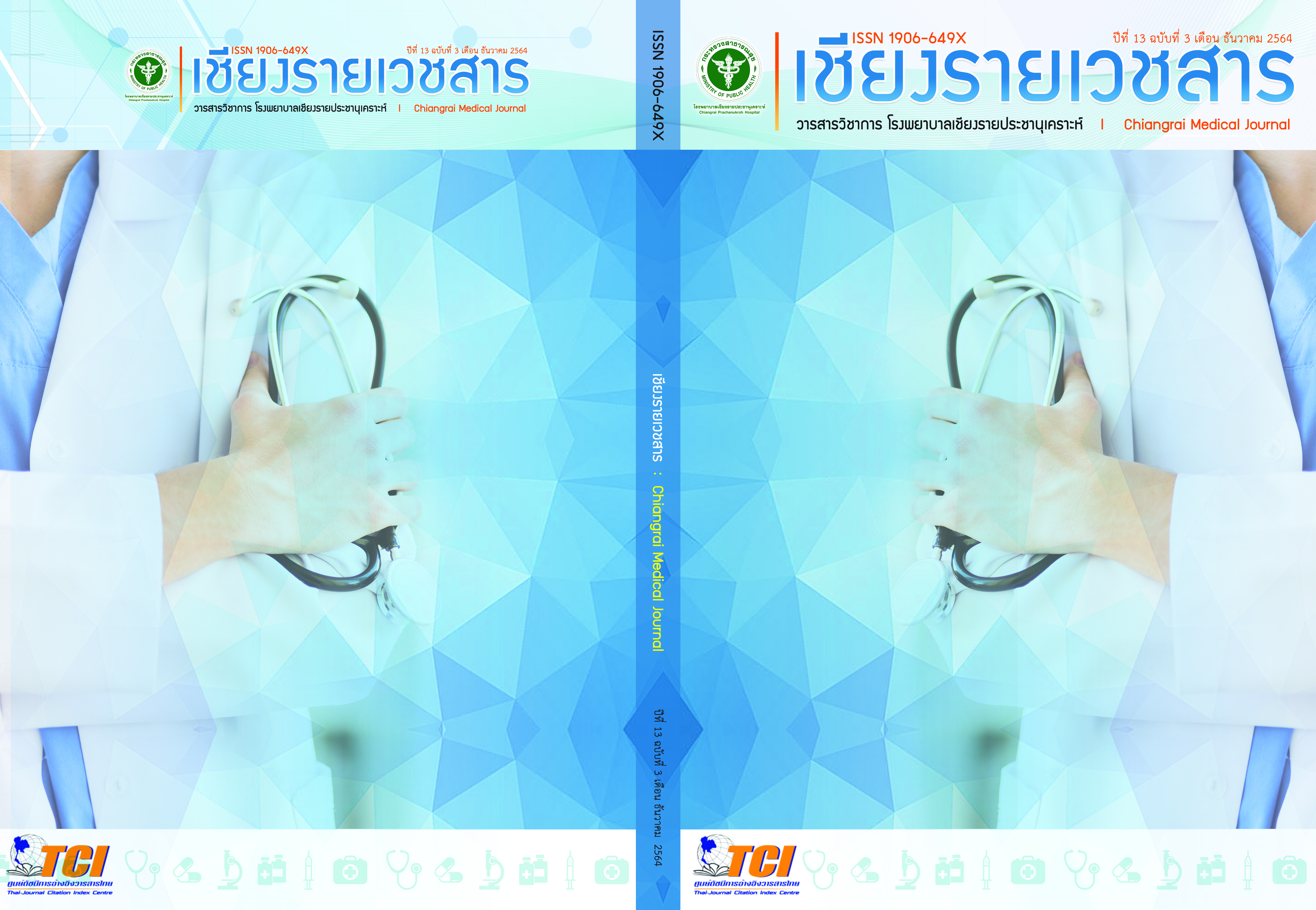ปัจจัยที่มีผลต่อการใส่ท่อช่วยหายใจในผู้ป่วยปอดอุดกั้นเรื้อรังที่มีอาการกำเริบเฉียบพลันรุนแรงนอกโรงพยาบาล
Main Article Content
บทคัดย่อ
ความเป็นมา: ปัจจุบันระบบบริการการแพทย์ฉุกเฉินได้เข้ามามีบทบาทมากขึ้นในการรักษาผู้ป่วยตั้งแต่นอกโรงพยาบาล ผู้ป่วยปอดอุดกั้นเรื้อรังที่มีอาการกำเริบรุนแรงจัดอยู่ในกลุ่มอาการหายใจเหนื่อยและเป็นกลุ่มอาการหลักที่รับแจ้งเหตุ โดยระบบบริการการแพทย์ฉุกเฉินจังหวัดเชียงรายได้ทำการรักษาผู้ป่วยปอดอุดกั้นเรื้อรังที่มีอาการกำเริบเป็นจำนวนมากขึ้นทุกปี
วัตถุประสงค์: เพื่อศึกษาปัจจัยที่มีผลต่อการใส่ท่อช่วยหายใจ (endotracheal tube) บนรถพยาบาลฉุกเฉินในผู้ป่วยปอดอุดกั้นเรื้อรังที่มีอาการกำเริบเฉียบพลัน
วิธีการศึกษา: เป็นการศึกษารูปแบบ observational retrospective cohort ในผู้ป่วยปอดอุดกั้นเรื้อรังที่มีอาการกำเริบที่เข้ารับการรักษาผ่านระบบการแพทย์ฉุกเฉินโรงพยาบาลเชียงรายประชานุเคราะห์ ตั้งแต่ 1 มกราคม 2561 - 31 ธันวาคม 2562 เก็บรวบรวมข้อมูลย้อนหลังจากแบบบันทึกการปฏิบัติงานการบริการการแพทย์ฉุกเฉินและวิเคราะห์ข้อมูลโดยใช้ t-test, exact probability test และ Logistic regression
ผลการศึกษา: ช่วงระยะเวลา 12 เดือนของการศึกษา จำนวนผู้ป่วยที่เข้าเกณฑ์การศึกษา 347 คน มีการใส่ท่อช่วยหายใจ 31 คน และไม่ได้ใส่ท่อช่วยหายใจจำนวน 316 คน ปัจจัยที่มีผลต่อการใสท่อช่วยหายใจในผู้ป่วยปอดอุดกั้นเรื้อรังที่มีอาการกำเริบรุนแรงอย่างมีนัยสำคัญทางสถิติ (p<0.05) ได้แก่ เพศชาย (OR 4.23, 95%CI 1.15-15.49, p=0.030) อัตราการหายใจมากกว่าเท่ากับ 30 ครั้งต่อนาที (OR 6.76, 95%CI 1.82-25.16, p=0.004) และค่าออกซิเจนในเลือดน้อยกว่าร้อยละ 88 (OR 5.15, 95%CI 1.85-14.35, p=0.002)
สรุปและข้อเสนอแนะ: ปัจจัยที่มีผลต่อการใสท่อช่วยหายใจในผู้ป่วยปอดอุดกั้นเรื้อรังที่มีอาการกำเริบอย่างมีนัยสำคัญทางสถิติ (p<0.05) ได้แก่ เพศชาย อัตราการหายใจมากกว่าเท่ากับ 30 ครั้งต่อนาที และค่าออกซิเจนในเลือดน้อยกว่าร้อยละ 88 ซึ่งควรนำไปประกอบการพัฒนาระบบการแพทย์ฉุกเฉินในการรักษาผู้ป่วยปอดอุดกั้นเรื้อรังที่มีอาการกำเริบรุนแรงนอกโรงพยาบาล
Article Details
เอกสารอ้างอิง
Global Initiative for Chronic Obstructive Lung Disease [Internet]. 2020 [cited ปีเดือนวันที] Available from: https://goldcopd.org/wp-content/uploads/2019/11/GOLD-2020-REPORT-ver1.0wms.pdf.
Groenewegen KH, Schols AM, Wouters EF. Mortality and mortality-related factors after hospitalization for acute exacerbation of COPD. Chest. 2003;124(2):459-67
Vestbo J, Hurd SS, Agustí AG, Jones PW, Vogelmeier C, Anzueto A, et al. Global strategy for the diagnosis, management, and prevention of chronic obstructive pulmonary disease: GOLD executive summary. Am J Respir Crit Care Med. 2013;187(4):347-65.
Faiprom N, Petsilasan R, Suwanno J, Ponphet C, Nakhwan N. Factors related to respiratory failure requiring invasive mechanical ventilator in chronic obstructive pulmonary disease with acute severe exacerbation. Journal of the department of medical services. 2019; 3:133-8.
Rodkantuk E, Hirunchunha S, Petsirasan R. Acute exacerbation symptoms among patients with chronic obstructive pulmonary disease, triggering factors, and management strategies. Songklanagarind Journal of Nursing. 2017; 3(2):1-13.
Ucgun I, Metintas M, Moral H, Alatas F, Yildirim H, Erginel S. Predictors of hospital outcome and intubation in COPD patients admitted to the respiratory ICU for acute hypercapnic respiratory failure. Respir Med. 2006;100(1):66-74.
Emergency Medical Triage Protocol and Criteria Based Dispatch. National Institute for Emergency Medicine; 2013.
Hasegawa W, Yamauchi Y, Yasunaga H, Sunohara M, Jo T, Matsui H, et al. Factors affecting mortality following emergency admission for chronic obstructive pulmonary disease. BMC Pulm Med. 2014;14:151.
Shorr AF, Sun X, Johannes RS, Derby KG, Tabak YP. Predicting the need for mechanical ventilation in acute exacerbations of chronic obstructive pulmonary disease: comparing the CURB-65 and BAP-65 scores. J Crit Care. 2012;27(6):564-70.
Germini F, Veronese G, Marcucci M, Coen D, Ardemagni D, Montano N, et al. Validation of the BAP-65 score for prediction of in-hospital death or use of mechanical ventilation in patients presenting to the emergency department with an acute exacerbation of COPD: a retrospective multi-center study from the Italian Society of Emergency Medicine (SIMEU). Eur J Intern Med. 2019;61:62-8.
Gopinathannair R, Olshansky B. Management of tachycardia. F1000Prime Rep. 2015;7:60.
Halpin DMG, Criner GJ, Papi A, Singh D, Anzueto A, Martinez FJ, et al. Global initiative for the diagnosis, management, and prevention of chronic obstructive lung disease. The 2020 GOLD Science committee report on COVID-19 and chronic obstructive pulmonary disease. Am J Respir Crit Care Med. 2021;203(1):24-36.
Echevarria C, Steer J, Wason J, Bourke S. Oxygen therapy and inpatient mortality in COPD exacerbation. Emerg Med J. 2021;38(3):170-7.
Zhang JB, Zhu JQ, Cao LX, Jin XH, Chen LL, Song YK, et al. Use of the modified Glasgow Coma Scale score to guide sequential invasive-noninvasive mechanical ventilation weaning in patients with AECOPD and respiratory failure. Exp Ther Med. 2020;20(2):1441-6.


